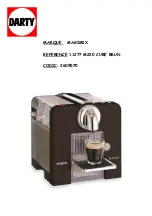
Copies of the I/B. Please reproduce them without any
changes except under special instruction from Team
International BELGIUM. The pages must be reproduced
and folded in order to obtain a booklet A5 (+/- 148.5 mm
width x 210 mm height). When folding, make sure you
keep the good numbering when you turn the pages of
the I/B. Don’t change the page numbering. Keep the
language integrity.
12
TKG BBA 2 – 080514
Assembly page 12/44
Fax +32 2 359 95 50
Yeast
Yeast, through a fermentation process produces gas (carbon dioxide) necessary to make
bread rise. Yeast must be able to feed on sugar and flour carbohydrates in order to produce
this gas. Active dry granular yeast is used in all recipes that call for yeast. There are basically
four different types of yeast available; fresh, dry, quick-rising and bread machine. It is
recommended that traditional dry yeast be used, however, quick-rising yeast can also be used
in lesser amounts.
Fresh or compressed cake yeast should never be used
, as they will produce
poor results.
Yeast must always be stored in a refrigerator to keep it fresh. Too much heat will kill it. Ensure
that your yeast is opened, it is important that the remaining contents be immediately resealed
and refrigerated as soon as possible for future use. Often bread or dough, which fails to rise, is
due to stale yeast being used. The following test can be done to determine whether your yeast
is stale and inactive:
Place ½ cup of lukewarm water into a small bowl or cup.
Stir 1 tsp of sugar into the water then sprinkle 2 tsp of yeast over the surface.
Place the cup in a warm area and allow sitting for 10 minutes undisturbed.
The mixture should foam and produce a strong yeast aroma. If this does not occur,
fresh yeast should be purchased.
Sugar
Sugar is important for the colour and flavour of breads. It is also food for yeast as it supports the
fermentation process. Recipes that call for sugar require granulated sugar. Do not substitute
powdered sugar or brown sugar unless indicated. Artificial sweeteners cannot be used as a
substitute for sugar as yeast will not react properly with them.
Salt
Salt is necessary to balance the flavour of breads and cakes, as well as for the crust colour that
develops during baking. For dietary reasons, it may even be eliminated entirely, however, your
bread may over-proof and rise higher than normal.
Liquids/milk
Liquid such as milk or a combination of powdered milk and water can be used when making
bread. Milk will improve flavour, provide a velvety texture and soften the crust, while water
alone will produce a crispier crust. Use only powdered milk when using the delay timer. Some
recipes call for juice (orange, apple, etc.) to be added as a flavour enhancer.
Eggs
Eggs add richness and velvety texture to bread dough and cakes. Use only large-size eggs in
these recipes.
Butter, oil and margarine
Butter, oil and margarine shorten or tenderise the texture of yeast breads. However, breads
that call for butter stay fresh longer. If butter or margarine is used directly from the refrigerator,
it should be cut into small pieces for easier blending during the kneading cycle.
Baking powder
Baking powder is a leavening agent used in quick breads and cakes. This type of leavening
agent does not require rising time before baking as the chemical reaction works during baking
process.
Baking soda
Baking soda is another leavening agent not to be confused with nor substituted for baking
powder. It also does not require rising time before baking as the chemical reaction works
during baking process.













































